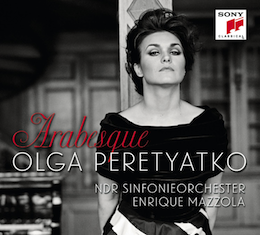Britten: Peter Grimes on Aldeburgh Beach (Arthaus Musik DVD and Blu-ray)
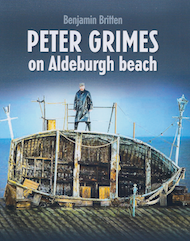
Of all the productions of Britten operas staged for the centennial celebration of his birth, in 2013, nothing can possibly top this open-air staging of Peter Grimes on Aldeburgh Beach. Britten found inspiration for his opera in a poem of George Crabbe, which invoked what Britten described, in his written introduction to Grimes’ 1945 premiere, as “that grim and exciting seacoast around Aldeburgh.” Just three years later, Britten and Pears joined with writer Eric Crozier to found the Aldeburgh Festival, which continues to thrive as the archival and performance center of Britten’s music and legacy.
To Britten, the importance of the Aldeburgh coast extended far beyond the opera itself. “For most of my life I have lived closely in touch with the sea,” he wrote of his parent's house in Lowestoft that directly faced the sea. “My life as a child was coloured by the fierce storms that sometimes drove ships on to our coast and ate away whole stretches of the neighbouring cliffs. In writing Peter Grimes, I wanted to express my awareness of the perpetual struggle of men and women whose livelihood depends on the sea …”
Indeed, when discussing Britten, Englishman John Atkinson, editor of Stereophile magazine, told me that were I ever to visit the Adeburgh coast, I would discover that the music of the orchestral interludes that stitch together the scenes of the opera actually sounds like that very landscape. How thrilling, then, to discover that for this video, the film’s director, Margaret Williams, cuts to John Walker’s time-lapse images of skies, seascapes, changing weather states, and the landscape of Britten’s “composing walks” in the marshes around Snape and along the Suffolk Coast.
For the performances, which took place in June 2013, the intentionally weathered, 131-foot-long set and costumes were meant to invoke the year of the opera’s premiere. The set stood right on the pebbles, on top of the slope of beach that led directly down to the sea; the audience sat on risers, watching from the beach. Conductor Steuart Bedford, conducted the Britten-Pears Orchestra from a “conducting hut” dug into the pebbles in front of the stage.
While no one would posit this performance as a musical replacement for Britten’s own recording, made over a decade after the premiere with his life partner Peter Pears in the title role, its sense of occasion makes it a must. Tenor Alan Opie, who tackles the role for the first time, gives a strong performance, squeezing out high notes beyond expectation. He’s hardly as eerie as Pears or Jon Vickers, but the visuals help immensely. Giselle Allen (Ellen Orford) screeches in her highest passages, but otherwise sings beautifully. You may not be thoroughly convinced by her acceptance of Grimes’ dark side, but you will certainly feel her compassion and that of David Kempster (Captain Balstrode). Gaynor Keeble is as convincing of Auntie’s madame-hood as is veteran artist Catherine Wyn-Rogers of Mrs. Sedley’s stiffnecked morality. Christopher Gillet as the hypocritical Rev. Horace Adams, and Charles Rice as free spirit Ned Keene are also excellent.
While I viewed the opera on my computer in DVD format, there is no question that the Blu-ray version’s superior sound will get you far closer to the sea sounds central to both opera and production. An alternative is the Signum 2-CD release of the same cast and forces, made at the 66th Aldeburgh Festival, which preceded the move to the beach by 10 days. The visuals, however, are as windswept as it gets short of abandoning ship, and hence essential to appreciation of the endeavor.
Olga Peretyatko Arabesque (Sony Classical CD)
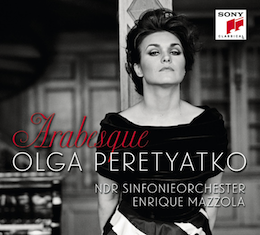
Coloratura alert: there’s a new high flyer on the scene. For her second Sony CD, Russian soprano Olga Peretyatko, who debuts at the Metropolitan Opera and La Scala this year, and returns to Salzburg and Aix-en-Provence in the summer, mixes mostly coloratura arias by Mozart, Rossini, Bellini, Verdi, Gounod, Bizet, and Johann Strauss with two well-worn showpieces, Dell’Acqua’s “Villanelle” and Arditi’s “Il Bacio.” If Peretyatko cannot negotiate runs with the alacrity of the late Joan Sutherland, nor always hit high E-flats spot on, her enunciation is clear, the coloratura near impeccable, and the voice bright, full, and instantly appealing. Except in her delightful performance of Johann Strauss’ preposterous “Spiel ich die Unschuld vom Lande” from Die Fledermaus, or a surprisingly charmless performance of Mozart’s “Deh vieni, non tardar” from Le nozze di Figaro, emotions are generalized, in the pre-Callas manner, with most of the attention placed on voice, melody, and historically appropriate embellishment. Nonetheless, given how fine her singing is, Peretyatko has few peers on today’s stages. You’ve got to hear her.
Meredith Monk: Solo Concert 1980 (Tzadik DVD)
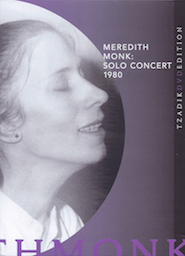
One of the wonders of contemporary song, dance, and performing art, the great and ever-endearing Meredith Monk holds forth in 53 minutes of solo vocalization, movement, and pianism that defy simple description. Performing in a simple blue jumpsuit before a small audience at the Inter-Media Art Center on Long Island, and videotaped in her absolute prime, Monk displays her astonishing range of extended vocal techniques. Her voices constantly change, from the quasi-classical technique of “Lullaby #4” (complete with cradling and caressing gestures) to the very sweet, high, and quasi-Japanese little girl sounds of “Jade.” You’ll encounter insects, Native American ritual, Tibetan overtone chanting, the amazing wild sounds of the prairie, and much more.
To some, Monk’s vocalizations may at first seem akin to nonsense sounds, albeit presented in a quasi-melodic fashion that makes them both instantly accessible and light-years away from the dense atonal serialism that preceded them. But the more you listen, the more you may sense that Monk taps into something very elemental, even primordial. As strange as she may initially seem, Monk speaks to the heart of the human condition. Ignore the poor focus and the constant hum; this video is gold.
Christiane Karg / Malcolm Martineau: Live from Wigmore Hall (CD)
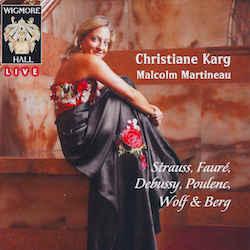
How wonderful to encounter the fresh, still youthful voice of a soprano who sings art song with a heartfelt integrity that explains her rapid rise to stardom. Bavarian-born Christiane Karg was not yet 32 when, on July 19, 2012, she stood before a Wigmore Hall audience to sing songs by Strauss, Fauré, Debussy, Poulenc, Wolf, and Berg, but she had already performed thrice at Salzburg Festival (debut, 2006), sung regularly at the Theater an der Wien, and won a host of awards that included ECHO Klassik’s 2010 “Young Artist” singing award.
Karg’s lyrical voice is, by itself, very special. Grounded in a full, pliant midrange, it rises to a shimmering high register that, especially in softer singing, provides constant delights. If her interpretations do not always achieve memorable profundity, they nonetheless speak to the heart of composers’ intentions with a beauty that engenders gratitude. Among the gems on the CD are Strauss’ “Die Nacht” (Night) and “Traum durch die Dämmerung” (Dreams at Twilight); Fauré’s “Nell” and “Les roses d’Ispahan” (The roses of Ispahan); Debussy’s “Green” and “Spleen;” Poulenc’s “Fleurs” (Flowers); Berg’s Seven Early Songs; and, for the final encore, Schumann’s “Du bist wie eine Blume” (You are like a flower). The title seems especially apt, given Karg’s golden voice. Please, please, may she sing in the Bay Area soon.

